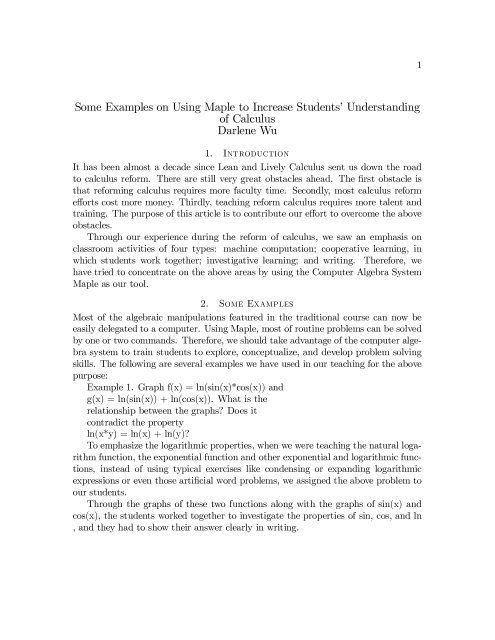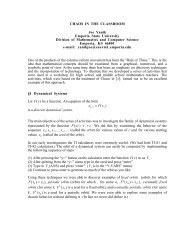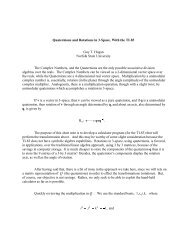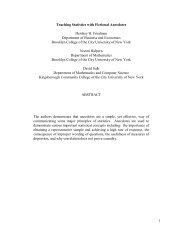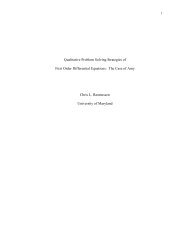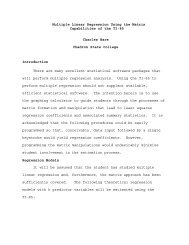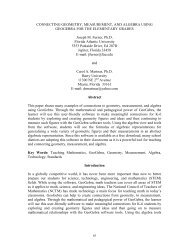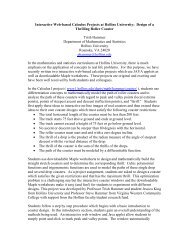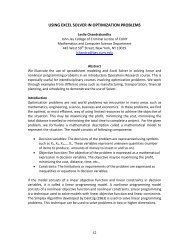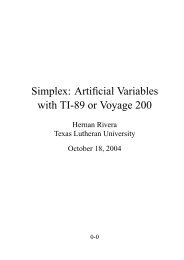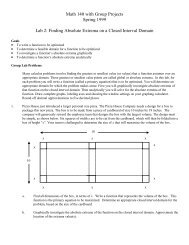Some Examples on Using Maple to Increase Students - Mathematics ...
Some Examples on Using Maple to Increase Students - Mathematics ...
Some Examples on Using Maple to Increase Students - Mathematics ...
You also want an ePaper? Increase the reach of your titles
YUMPU automatically turns print PDFs into web optimized ePapers that Google loves.
1<br />
<str<strong>on</strong>g>Some</str<strong>on</strong>g> <str<strong>on</strong>g>Examples</str<strong>on</strong>g> <strong>on</strong> <strong>Using</strong> <strong>Maple</strong> <strong>to</strong> <strong>Increase</strong> <strong>Students</strong>’ Understanding<br />
of Calculus<br />
Darlene Wu<br />
1. Introducti<strong>on</strong><br />
It has been almost a decade since Lean and Lively Calculus sent us down the road<br />
<strong>to</strong> calculus reform. There are still very great obstacles ahead. The …rst obstacle is<br />
that reforming calculus requires more faculty time. Sec<strong>on</strong>dly, most calculus reform<br />
e¤orts cost more m<strong>on</strong>ey. Thirdly, teaching reform calculus requires more talent and<br />
training. The purpose of this article is <strong>to</strong> c<strong>on</strong>tribute our e¤ort <strong>to</strong> overcome the above<br />
obstacles.<br />
Through our experience during the reform of calculus, we saw an emphasis <strong>on</strong><br />
classroom activities of four types: machine computati<strong>on</strong>; cooperative learning, in<br />
which students work <strong>to</strong>gether; investigative learning; and writing. Therefore, we<br />
have tried <strong>to</strong> c<strong>on</strong>centrate <strong>on</strong> the above areas by using the Computer Algebra System<br />
<strong>Maple</strong> as our <strong>to</strong>ol.<br />
2. <str<strong>on</strong>g>Some</str<strong>on</strong>g> <str<strong>on</strong>g>Examples</str<strong>on</strong>g><br />
Most of the algebraic manipulati<strong>on</strong>s featured in the traditi<strong>on</strong>al course can now be<br />
easily delegated <strong>to</strong> a computer. <strong>Using</strong> <strong>Maple</strong>, most of routine problems can be solved<br />
by <strong>on</strong>e or two commands. Therefore, we should take advantage of the computer algebra<br />
system <strong>to</strong> train students <strong>to</strong> explore, c<strong>on</strong>ceptualize, and develop problem solving<br />
skills. The following are several examples we have used in our teaching for the above<br />
purpose:<br />
Example 1. Graph f(x) = ln(sin(x)*cos(x)) and<br />
g(x) = ln(sin(x)) + ln(cos(x)). What is the<br />
relati<strong>on</strong>ship between the graphs Does it<br />
c<strong>on</strong>tradict the property<br />
ln(x*y) = ln(x) + ln(y)<br />
To emphasize the logarithmic properties, when we were teaching the natural logarithm<br />
functi<strong>on</strong>, the exp<strong>on</strong>ential functi<strong>on</strong> and other exp<strong>on</strong>ential and logarithmic functi<strong>on</strong>s,<br />
instead of using typical exercises like c<strong>on</strong>densing or expanding logarithmic<br />
expressi<strong>on</strong>s or even those arti…cial word problems, we assigned the above problem <strong>to</strong><br />
our students.<br />
Through the graphs of these two functi<strong>on</strong>s al<strong>on</strong>g with the graphs of sin(x) and<br />
cos(x), the students worked <strong>to</strong>gether <strong>to</strong> investigate the properties of sin, cos, and ln<br />
, and they had <strong>to</strong> show their answer clearly in writing.
2<br />
<strong>Students</strong> can use <strong>Maple</strong> <strong>to</strong> draw the two graphs easily, but the two graphs looked<br />
entirely di¤erent. Does this c<strong>on</strong>tradict the property ln(x*y) = ln(x) + ln(y) How<br />
would students explain it<br />
After several repetiti<strong>on</strong>s of the experiment and recalling the de…niti<strong>on</strong>s and properties<br />
of ln, sin and cos, the students may observe that because of the periodic propertity<br />
of sin(x) and cos(x), the two graphs look di¤erent, whereas they are identical<br />
as l<strong>on</strong>g as ln(sin(x)cos(x)) and ln(sin(x))+ln(cos(x)) are de…ned.<br />
Example 2. Evaluate the integral<br />
Z 1 µ µ <br />
1 1<br />
sec<br />
4 ¼t ¡tan<br />
4 ¼t dt<br />
0<br />
and graph the regi<strong>on</strong> whose area is given<br />
by the integral.<br />
Usually, the noti<strong>on</strong> of tan or sec will give students who are majoring in liberal<br />
arts and reluctantly taking math such uneasiness that they may get completly stuck.<br />
Fortunately, by using <strong>Maple</strong> as their <strong>to</strong>ol, students can easily …nd answers without<br />
any di¢culty and at the same time gain back some c<strong>on</strong>…dence, a feeling of triumph<br />
and a better understanding of the c<strong>on</strong>cept of integrati<strong>on</strong>. They may need <strong>to</strong> explore<br />
a little when<br />
they graph the functi<strong>on</strong>.<br />
Example 3. Let<br />
µ<br />
f := x ! 1+ 1 x<br />
x<br />
a) Graph the functi<strong>on</strong><br />
b)Estimate<br />
µ<br />
lim 1+ 1 x<br />
x!1 x<br />
c) Complete the following table<br />
x | 1 2 5 10 100 1000 10000<br />
f|<br />
Again, through the machine computati<strong>on</strong>, students didn’t have trouble <strong>to</strong> …nd<br />
answers for a) and b), but when they started <strong>to</strong> calculate f(1000), the computer gave<br />
them a outrageous number.<br />
What was going <strong>on</strong> Looking back <strong>to</strong> part b) and using the c<strong>on</strong>cept of the limit,<br />
the students knew the answer couldn’t be right. They had <strong>to</strong> try di¤erent approaches,<br />
like writing 1=x as x ¡1 , or put a paranthesis around 1=x, .... Finally, they decided <strong>to</strong><br />
put 1/1000 as 0.001, and this time they were right!<br />
> (1+0.001)^1000;<br />
2:716923932
3<br />
These kind of exercises not <strong>on</strong>ly provided opportunity <strong>to</strong> reinforce the c<strong>on</strong>cept of<br />
limits, but also enhanced students’ arithmetic and algebra skills.<br />
Example 4. Choose two positive numbers for a and b.<br />
Use these two values <strong>to</strong> de…ne a functi<strong>on</strong>.<br />
a) Write down two equati<strong>on</strong>s <strong>to</strong> be solved<br />
in order <strong>to</strong> …nd the critical points of f.<br />
b) To solve for the critical points, the<br />
above two equati<strong>on</strong>s can be combined<br />
<strong>to</strong> a single equati<strong>on</strong> involving y <strong>on</strong>ly.<br />
Writedownsuchanequati<strong>on</strong>.<br />
c) Use <strong>Maple</strong> <strong>to</strong> solve for y.<br />
d) Determine the nature of the critical<br />
points.<br />
e) Determine the values of x and y, with<br />
which <strong>to</strong> see how f behaves near the<br />
…rst critical points from the picture of<br />
f.<br />
f) De…ne a new functi<strong>on</strong> g as f+3. By the<br />
previous calculati<strong>on</strong>, what are the<br />
critical points of g and their nature<br />
Explain.<br />
This example o¤ers a good chance for students <strong>to</strong> look at the whole picture of<br />
…nding the extrema for a given multi-variables functi<strong>on</strong> using the Sec<strong>on</strong>d Derivatives<br />
Test.Typically, students would have <strong>to</strong> struggle in the computati<strong>on</strong> swamp and try<br />
<strong>to</strong> avoid careless mistakes. <str<strong>on</strong>g>Some</str<strong>on</strong>g> times they would simply get lost in the middle of<br />
the process. Now <strong>Maple</strong> can free them from the tedious calculati<strong>on</strong> so that they can<br />
keep a clear mind <strong>on</strong> the task and can even make a c<strong>on</strong>necti<strong>on</strong> back <strong>to</strong> the derivative<br />
rules.<br />
The following two examples will help students <strong>to</strong><br />
visualize solids of revoluti<strong>on</strong>.<br />
Example 5. Find the volume of the solid by rotating<br />
about the x-axis the regi<strong>on</strong> under the curve<br />
> f:= (x) -> (5*x)^(1/2);<br />
f := x ! p 5 p x<br />
><br />
from x=0 <strong>to</strong> x=1.<br />
Example 6. Find the volume obtained by revolving the
4<br />
regi<strong>on</strong> bouned by<br />
> eq1 :=y=x^2/3;<br />
eq1 := y = 1 3 x2<br />
> eq2 :=y=2*x;<br />
eq2 := y =2x<br />
abouttheliney=15inthex-yplane.<br />
3. C<strong>on</strong>clusi<strong>on</strong><br />
In looking at the substantial changes that technology has brought in the recent years,<br />
we believe that instructi<strong>on</strong> in mathematics will have <strong>to</strong> catch up with the new circumstances<br />
or else become increasingly irrelevant. With added pressure from the rapid<br />
development of informati<strong>on</strong> super highway, it is even more demanding <strong>to</strong> train our<br />
students <strong>to</strong> think clearly, critically, c<strong>on</strong>structively, and creatively about the problems<br />
they might encounter in the real world. It is our job <strong>to</strong> help students <strong>to</strong> gain the<br />
ability that will enable them <strong>to</strong> use mathematical methods and <strong>to</strong>ols whenever they<br />
seem appropriate and helpful. To this end, computer-oriented mathematics courses,<br />
focusing <strong>on</strong> coorperative learning, problems solving, and investigative learning and<br />
writing are an important part of the educati<strong>on</strong> for our students.<br />
On the other hand, through our experience of integrating <strong>Maple</strong> in<strong>to</strong> teaching the<br />
calculus sequence, we feel questi<strong>on</strong>s like these still need <strong>to</strong> be answered. a) How much<br />
technology is <strong>to</strong>o much We d<strong>on</strong>’t want students become <strong>to</strong>o dependent <strong>on</strong> it. b) If<br />
something went wr<strong>on</strong>g during the process of using <strong>Maple</strong>, students may panic because<br />
they d<strong>on</strong>’t know whether it was a math problem or they did something wr<strong>on</strong>g. How<br />
do we help students <strong>to</strong> identify such problems and solve them e¢ciently We hope<br />
we will be able <strong>to</strong> …nd satis…ng answers in the near future.<br />
4. References<br />
1. William E. Boyce, New Directi<strong>on</strong>s in Elementary Di¤erential Equati<strong>on</strong>s, College<br />
<strong>Mathematics</strong> Journal 25:5 (1994) 364 - 371.<br />
2. John S. Devitt, Calculus with <strong>Maple</strong> V, Brooks/Cole Publishing Company,<br />
1993.<br />
3. C.K. Cheung and John Harer, Multivariable Calculus with <strong>Maple</strong> V, Preliminary<br />
Editi<strong>on</strong>, John Wiley and S<strong>on</strong>s,Inc, 1994.<br />
4. Michael C. Reed, SIAM News 27:7 (1994).<br />
5. Joe Brown, Report <strong>to</strong> the Calculus C<strong>on</strong>sortium, The Appalachian Journal of<br />
School and College <strong>Mathematics</strong>, Fall 1993 Vol.1, Issue 1.


